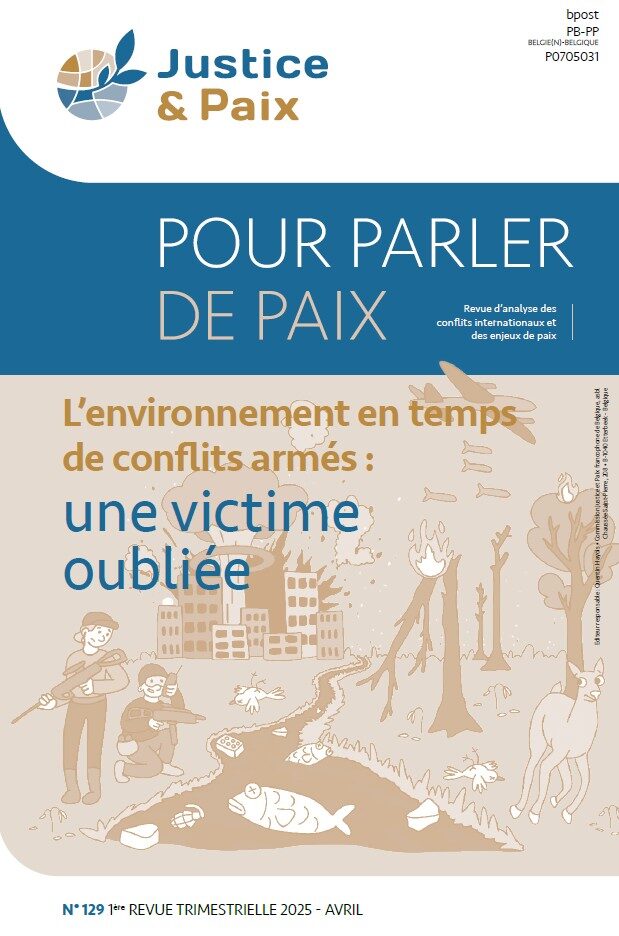Reconciliation is often considered in an interpersonal way but it is rarely considered as a significant societal issue. In this short analysis, we try to explain the concept and why it is worth focusing on for a future focused on a peaceful (re)living together between peoples.

Le concept de « réconciliation » est un élément crucial dans le domaine du “peacebuilding” (la construction de la paix), en particulier lorsqu’il s’agit de s’attaquer aux racines profondes des conflits et de prévenir la réapparition de nouvelles violences. C’est une notion qui va au-delà de la simple cessation des hostilités ; elle touche aux émotions, à la psychologie et à la société dans son ensemble.
Avec la multiplication des conflits intraétatiques depuis les années 1990, ainsi que la généralisation des opérations internationales de maintien de la paix et la reconnaissance de la sécurité humaine comme un des “piliers du développement”, la notion de “postconflit” est devenue une grille de lecture et d’action internationale commune. Défini par les Nations unies, le concept de “postconflit” désigne un modèle idéal de transition après une guerre, au sein duquel institutions internationales, États et acteur·rices civils, privés et associatifs œuvreraient ensemble pour surmonter les tensions et (re)construire une paix durable. Toutefois, l’approche institutionnelle du concept connait encore, à ce stade, certaines fragilités dans ses questionnements fondamentaux et sa méthode[1]. Indeed, reconciliation cannot be imposed from the outside; it must come from the hearts of individuals and be adapted to the cultural and historical particularities of each society. Furthermore, reconciliation should not be seen as a simple “step” in the peace process, but as a long-term commitment to harmonious coexistence.
It is in this context that key concepts such as “reconciliation” emerge in the field of international relations. If this concept had already been studied in the past, it was mainly in its aspect of interpersonal relations and not in a context of armed conflict. At that time, the lack of consensus on a definition of the concept made it vague and thus allowed interpretations and manipulations. It was only from the 2000s that a global reflection began on the work of post-armed conflict reconciliation in academic circles.
A journey and a destination
Reconciliation can mean the establishment of change on the one hand (the process), and the achievement of this change (the result) on the other hand. About the result, we are no longer talking only about a cessation of hostilities or the signing of a peace treaty, but about “la formation ou restauration d’une réelle relation de paix entre [groups of the] Company[s] who were involved[es] dans un conflit insoluble, après la résolution formelle de ce conflit”[2], as previously mentioned. It is important to point out that this outcome involves the entirety of society, and not just political leaders. Regarding the process, specialists generally identify three phases which can be linked to the stages of conflict resolution, that is to say: 1° the agreement to end the conflict; 2° coexistence; and 3° the period of establishment of peace. One of them, Herbert Kelman, an expert in social psychology, puts it this way:[3] :
- Mutual tolerance of stakeholders. This leads them to agree to lay down their arms and enter into negotiations. This first phase is always linked to the personal (but shared) interest of the stakeholders: the fact that the state of peace represents a better situation for them than the state of conflict;
- A period of identification, which is no longer just coexistence and respect for laws (we are not waging war), but also a desire to maintain ties;
- A stage of internalization, where peace has become a value for different groups.
Valérie Rosoux, another expert specializing in questions of memory and reconciliation in post-war contexts, presents things a little differently[4]. For her part, she believes that it could be possible to consider three conceptions of reconciliation:
- Minimal (a political agreement and we tolerate each other);
- Intermediate (coexistence with convergence of interests and needs of each party);
- Maximal (the process manages to transcend past divisions between groups). However, this last phase is not always possible.
To summarize these two aspects, process and result, we will propose the following definition of reconciliation: “une idée autant qu’une pratique qui vise la guérison individuelle et collective dans des situations où des torts qui semblent irréversibles ont laissé les gens dans une relation brisée caractérisée par la peur, la défiance et la colère”[5].
One question remains unanswered all the same: what reconciliation are we talking about? There are three approaches[6] in the way of conceiving reconciliation:
First, there is the structural approach which is based on the mutual interests of states and parties, and works on political and social mechanisms. It results in the establishment of common institutional and structural mechanisms aimed at reducing the feeling of threat, preventing any disagreement and increasing the feeling of security. It may be political collaboration between former enemy states, economic interdependence or even a common armed force... In the case of an intrastate conflict, the measures may be to promote freedom of expression, return or establishment of political plurality, etc. This approach can be illustrated by the Franco-German reconciliation after the Second World War, which was, among other things, maintained by the creation of European institutions. This has nevertheless been criticized for the fact that it only involves political leaders, elites or state structures, but not the rest of the population. Furthermore, it takes into account the material aspects of a conflict, but not the aspects of group identities, values and emotions.
Secondly, there is the psychosocial approach which goes a step further. Beyond the interests of the parties, we try to work on the emotional, stereotypes, beliefs and prejudices of each party. This approach aims further than coexistence, it includes changes in mentalities and the desire to build a new horizon together. This approach was developed in view of the shortcomings of the structural approach.
Thirdly, there is the spiritual approach which proposes to combine understanding the (re)creation of a relationship between people, via justice and forgiveness. It draws on local religious or spiritual traditions. This is a very ambitious approach, which is sometimes not feasible. It aims to achieve the rehabilitation in society of both victims and perpetrators, to understand everyone as humanity. As an example, we can cite Desmond Tutu, in South Africa, who defended this approach through his religious commitment.
| “One obstacle is that, for some, reconciliation is seen as a by-product, a result or even a condition of forgiveness. It is indisputable that forgiveness can sometimes be a factor of reconciliation, but it is not a necessary factor.[7]. Le pardon, puisqu’il touche à la spiritualité, à la morale ou à la religion, est une composante appartenant à la sphère de l’intimement personnel. En tant que tel, il peut être un élément de réconciliation. Toutefois, dans de nombreux contextes post-conflits, nous constatons qu’il n’y a pu y avoir de réconciliations sans pardon. Le passage devant la justice peut être un moyen d’y parvenir. Par ailleurs, le pardon n’est pas non plus une condition nécessaire à une certaine réhabilitation des auteurs et autrices. |
Il est important de préciser que cette classification demeure une grille de lecture, et les conflits sont toujours plus complexes dans la réalité. Une approche n’est pas meilleure que l’autre, et va surtout dépendre des besoins des individus et des collectifs. Des “pièges” existent dans chaque approche. Dans l’approche structurelle par exemple, on va privilégier la réconciliation de fait, basée sur la cohésion sociale et le vivre-ensemble de différents groupes. Il faut se méfier du risque que deux groupes vivent côte à côte, littéralement co-existent, mais que la haine demeure présente. Dans ce contexte, un conflit pourrait resurgir à la moindre étincelle. Tandis que dans l’approche spirituelle, il ne peut y avoir d’injonction. Qui serait-on pour imposer à une victime de se réconcilier avec son bourreau ? Cela restera donc impossible pour beaucoup de personnes.
How does this concern us as Belgians?
Reconciliation is not only relevant to war-torn societies. Even for a nation like Belgium, which has not directly experienced major conflicts for generations, understanding the dynamics of reconciliation is essential to grasp the nuances of current political and social issues. This helps us in particular to better understand the underlying mechanisms of societies around the world.
Conflict, whether visible or hidden in the shadows, has always shaped human history. From the outside, it's easy to assume that once a conflict is resolved and the weapons are laid down, life returns to normal. In reality, after the ceasefire, a crucial phase begins: that of reconciliation. If this step is neglected, the seeds of new clashes may germinate. Take the example of the Second World War which emerged from the poorly resolved vestiges of the First, notably with the consequences of the Treaty of Versailles of 1919.
Reconciliation is both a process and an outcome. It touches on political and social aspects as well as emotional and spiritual dimensions. Evoking reconciliation also means addressing themes such as responsibility, victimization, forgiveness and the quest for truth. These concepts are fundamental to building a harmonious and peaceful future between nations.
Through this humble analysis, inspired by the educational tool “Mémoriaction” of the Justice & Peace Commission, we want to underline the relevance of reconciliation for contemporary Belgium. We therefore invite you to explore this tool to deepen this reflection.
Emmanuel Tshimanga.
[1] Cattaruzza, Amaël, et al. “Postconflict: between war and peace? ". Herodotus, 2015/3 (no. 158), p. 6-15.
[2] Bar-Tal Daniel, et al. “The Nature of Reconciliation as an Outcome and as a Process”. From Conflict Resolution to Reconciliation, 2004, p.14.
[3] Kelman, Herbert C. “Reconciliation as Identity Change: A Social-Psychological Perspective.” From Conflict Resolution to Reconciliation, 2004, p.111-124.
[4] Rosoux, Valérie. “Reconciliation as a Puzzle: Walking Among Definitions.” Negotiating Reconciliation in Peacemaking: Quandaries of Relationship Building, 2017, p.15-26.
[5] Krondorfer, Björn. " Introduction. Social and political reconciliation. Reconciliation in global context: why it is needed and how it works, 2018, p.1-15.
[6] Rosoux, Valérie. “Reconciliation as a Peace-Building Process: Scope and Limits”. The Sage Handbook of Conflict Resolution, 2008, p. 543-563.
[7] O'Leary Sean, et al. “To experience reconciliation”, 2001, p.90.





